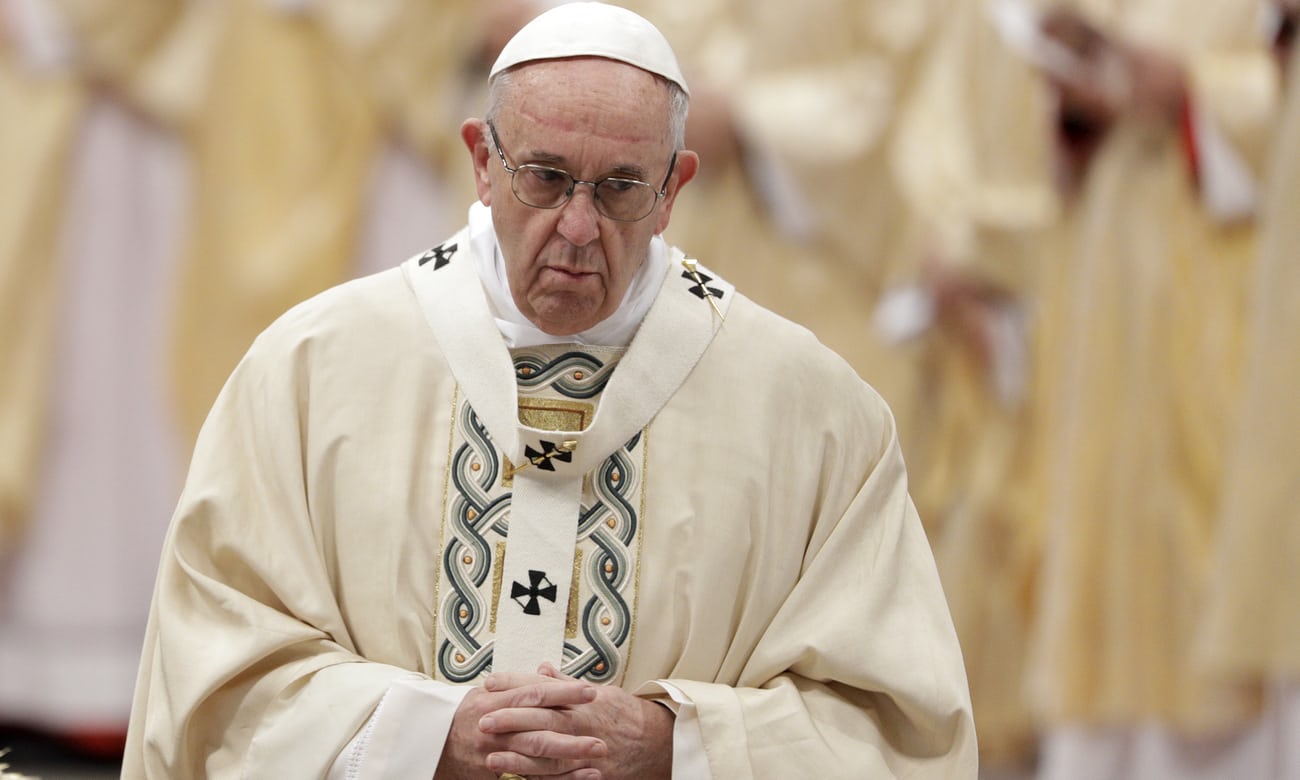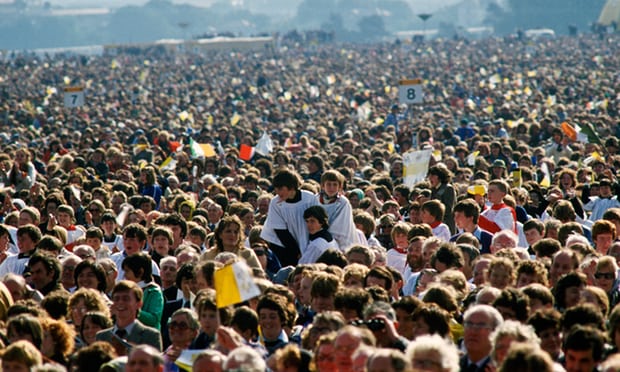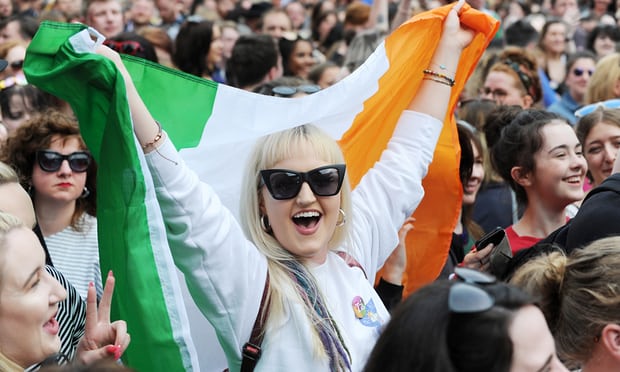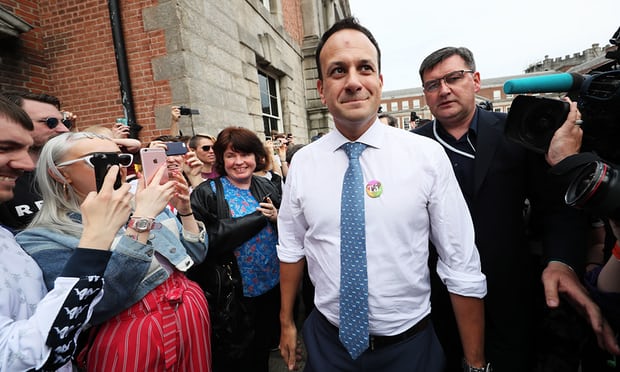When Faith Fades: Can the Pope Still Connect with a Changed Ireland?
By Harriet Sherwood
In the four decades since the last papal visit, Ireland has embraced divorce, contraception, same-sex marriage and abortion – and the Catholic church appears to be losing its hold on the people. How will Pope Francis deal with these issues when he arrives on 25 August? In the past four decades Ireland has become a different country, but you wouldn’t know it in Knock. In the small west of Ireland town that is home to the huge Marian shrine complex, it was hard to find a space on the tightly packed pews at 11am mass last week. The rows of the faithful – some women’s heads draped with lace – offered responses to the priest in confident voices. Outside the chapel, built on the spot where 15 people believed they witnessed an apparition of the Virgin Mary in 1879, pilgrims filled bottles with holy water at a line of fonts or queued to complete mass cards for loved ones. Priests were available to hear confession. An office across Main Street offered a marriage introduction service – “all applications treated in strictest confidence”. The facade of the Fairfield restaurant was being repainted in Vatican yellow, and finishing touches being put to a gleaming new piazza opposite the shrine. Souvenir shops were already stocked with “Pope Francis 2018” fridge magnets, alongside rosaries and figurines. “The excitement is palpable,” said Father Richard Gibbons, Knock’s parish priest for the past six years. In two weeks’ time, the papal plane will touch down at Knock’s international airport, privately built and operated to cater for 1.5 million-plus annual visitors to the shrine, many seeking a miraculous cure for physical or psychological ailments. The pope will spend an hour at the shrine – a few moments of private prayer, an address to those gathered outside the vast basilica and a whizz round in his popemobile – during a 36-hour visit to Ireland, most of which will be spent at the World Meeting of Families in Dublin. Remarkably, his trip will be only the second papal visit to a country noted for its Catholic traditions. The first was 39 years ago, when Pope John Paul II also visited Knock on the centenary of the apparition. Some 450,000 people turned out to see him there; in total, an estimated 2.5 million – more than half the combined population of the Republic of Ireland and Northern Ireland at the time – attended events or cheered on the streets during the three-day trip. This time 45,000 tickets have been allocated in Knock. “With the level of interest we’ve had, we could have quadrupled that,” said Gibbons. Half a million tickets have been distributed for the papal mass in Dublin’s Phoenix Park. Ireland has changed profoundly between the two papal visits – “1979 and today are a world away in every regard,” said Gibbons. “Francis is well aware of that, and he may address those changes while he’s here. He’s not one for shirking difficult issues.”
There is no shortage of such issues for the pope to choose from. The legacy of decades of clerical sexual abuse and cover-up; the cruelty meted out to vulnerable women in the notorious Magdalene laundries; the forced adoption by Catholic agencies of babies born to unmarried women; the robust rejection this spring by the Irish population of church teaching on abortion; the slump in people attending mass, down to 2% of the population in some districts of Dublin; the crisis in vocations (the recruitment of priests) which means that within a few years even if people are inclined to go to mass, there will be no priest to lead it. This autumn another symbolic pillar of Catholicism is expected to fall when the Irish people vote on removing the offence of blasphemy from the country’s constitution. The referendum will be held just a few months after Francis declared that “blasphemy, the sin against the Holy Spirit, is the only unpardonable sin” in an address from St Peter’s Square. According to Diarmuid Martin, archbishop of Dublin and president of the World Meeting of Families, speaking when the papal itinerary was announced, Francis’s visit “comes as the church in Ireland struggles to find a new place in Irish society and culture – a very different one from the dominant one it held in the past.” In the past four decades Ireland has embraced divorce, contraception, same-sex marriage and abortion, all once unimaginable in a country where the church and the state were in an intimate partnership. In 1979, 93% of the population still identified as Catholic and went to mass every week. Since then, there has been a marked downward trajectory of the proportion of the population identifying as Catholic to 78% at the 2016 census, while the second largest – and growing – category is people who say they have no religion, at around 10%. A study commissioned in 2015 by the archdiocese of Dublin from consultancy firm Willis Towers Watson predicted that attendances at mass would fall by a third in the 15 years to 2030, on top of a 20% drop between 2008 and 2014. It forecast a plunge of up to 70% in the number of working priests, with about three- quarters of those remaining in post over the age of 60. In recent weeks, the Association of Catholic Priests, which represents about a third of Irish clergy, has held four public meetings and conducted an online survey asking people for their views on the issues Pope Francis should address during his visit. There have been three main areas of concern, said Father Brendan Hoban. “The first is the vocations crisis. There is a eucharistic famine on the horizon; dioceses and parishes will soon be unable to hold mass because there are no priests available,” he said, with many people urging the ordination of women and married men as a way out of the crisis. “The second is abuse. People are frustrated and upset that this hasn’t been dealt with properly. The church is still scrambling to come to terms with it, and clear leadership is needed to put it behind us. “The third is the huge disconnect between the lives that priests and bishops live, the clerical world, and where people are at. The issues and concerns of people in the pews are not shared by priests around the altar. We’re embedded in a clerical culture that is completely at odds with the lives people are living and the issues they want dealt with.”
He gave as examples the church’s teaching on contraception – reinforced by a recent papal commission but widely ignored by Catholics – and a desire to accept and embrace LGBT people. “The reality is that people on the ground are making decisions for themselves. They are not looking to Rome for answers,” said Hoban. The pope was in tune with grassroots Catholics on many issues, he said. “The people and the pope are together – the problem is in the middle. There are huge forces of opposition against him. It’s simplistic to say he’s the pope, he can change things, when there is a whole number of people in the Vatican working against him, not working for him.” The church was “on the ropes”, said Father Joe McDonald, a parish priest and the author of a controversial book, Why the Irish Church Deserves to Die. “There’s no doubt the papal visit will give us a much-needed boost, but we’ve made a right mess, and there’s been an across-the-board rejection of the institutionalism of religion. I’d love Francis to address what I see as a dying, dysfunctional church, and say something new and fresh.” Leo Varadkar, the Irish taoiseach – who, as an openly gay man of Indian heritage, is himself an emblem of a changed country – has said he intends to challenge Francis on same-sex marriage and the legacy of abuse. The pope is expected to have a private meeting with survivors of abuse during his trip, although no details have been made public. Any meeting was likely to be with a “select group”, said Colm O’Gorman, executive director of Amnesty International Ireland, who was raped and abused by a priest in the 1980s. “And then some kind of statement will emerge, saying that he was moved by what he heard, that he felt their pain, that he regrets the actions of priests that caused such harm and so on. “But that’s very different from saying ‘I failed, my institution failed, and as pope I’m taking responsibility.’ If the pope wants to do something profound, he should come here and tell the truth, but the chances of that are very slim. The thing the church fears most is the damage to its reputation.” This year, on a visit to Chile, the pope denounced survivors who had said the church had covered up sexual abuse and crimes, and robustly defended a bishop he had appointed despite objections. The pope was later forced to apologise, launch an investigation into abuse and cover-up in the country, and accept the resignation in June of the bishop he had championed. It was a highly damaging episode for Pope Francis, and has been followed by high-profile sexual abuse scandals in the US and Australia involving senior church figures.
“Have they learned nothing? How can anyone say Francis is taking seriously the issue of abuse, and critically the issue of accountability for abuse, and ensuring there is deep, systemic change within the culture, practice and law of the Roman Catholic church?” said O’Gorman. “There are hundreds of thousands of people in this country who are struggling with the long-term impact of abuse and violation, and the church seems to think all that can be disappeared. When I look back to 1979, I think about a pope who is now a saint telling the young people of Ireland that he loved them at the same time as his institution colluded with, facilitated and covered up the rape and abuse of children, and other grave abuses against women and also men. Advertisement “Today, there’s a significant body of people who won’t put up with that kind of silencing of abuse. This is not that Ireland. This is a different Ireland.” Some say it is too late, that there is nothing that can halt – let alone reverse – the seemingly inexorable decline of the church and its waning influence in Ireland. The pattern is echoed in other countries in western Europe and in north America, but the global picture is far from bleak for the church. In the past half a century, Catholicism has shifted southwards. More than 40% of the world’s 1.2 billion Catholics live in Latin America, but the biggest growth in recent decades has been in sub-Saharan Africa – from 45 million in 1970 to 176 million in 2012. Asia has also seen growth and now represents almost 12% of the total Catholic population in the world, estimated at 137 million people. In many countries where Catholicism is thriving, the influence of the church on social attitudes and government policies is undeniable. Just last week, lawmakers in Argentina voted against legalising abortion after pressure from local bishops and Pope Francis, the former archbishop of Buenos Aires. But others hope the church in Ireland can recover, and that Francis’s visit may mark the beginning of that process. “The majority of people still see themselves as Catholic. An awful lot have lost hope in religion, but very few people have lost their faith in God,” said Hoban. “We need to envelop these people in a church which doesn’t demand unrealistic expectations of them.” In Knock, Gibbons said there was “no silver bullet”. “Can the tide be turned? It’s beyond that; we’re not even dealing with the same body of water. I’m not interested in turning back anything, going back to fantasy, halcyon days. We have to go forward, be creative, find new ways of engaging people. It will be hard work, but I believe we can re-evangelise this country.” Resting her weary legs outside the shrine, Eileen Meehan, 73, from Dunmore in County Galway, said: “People say there’s no faith in Ireland any more, but there’s a lot of excitement about the pope coming. I know there are fewer people going to mass. They’re letting other things take over their lives, like money and pleasure – they think this is the life, but it’s not. It’s very sad. But the Lord will bring them back.”
|
.
Any original material on these pages is copyright © BishopAccountability.org 2004. Reproduce freely with attribution.



